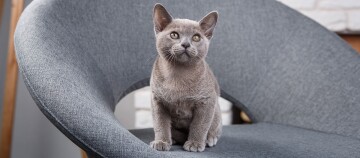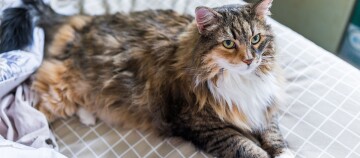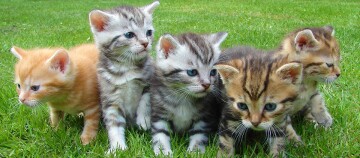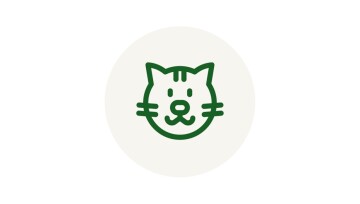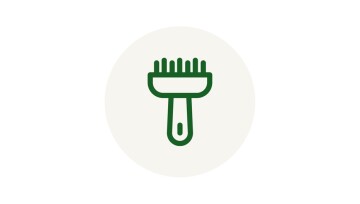Bengal Cat - Mini Leopard on the Outside, Lovable Friend on the Inside
07.10.2022 - Reading time: 4 minutes

The Bengal cat is also referred to as the Leopardette. Although it looks like a miniature feline predator, it is a particularly friendly pedigree cat. It is not only very beautiful, but also very cuddly and loves to play. This cat's clever and adventurous nature means that it places very special demands on its owner. If you give the Bengal cat enough space, attention and entertainment, you may well find it to be the ideal housemate.
NewsletterBengal cat
Breed | Bengal Cat or Leopardette |
Origin | USA |
Size | medium to large, up to 40 cm shoulder height and 110 cm head-tail length |
Weight | Female 3 to 4 kg, male 5 to 8 kg |
Physique | slim, muscular, black pads |
head shape | small and roundish, ears set wide apart and tilted forward |
Eyes | large, oval; black “eyelid line” extending from the corners of the eyes |
Coat and colour | short to medium-length, dense coat with silky soft texture; variable basic colours such as brown, golden, silver, orange or blue with the typical spot or marble markings |
Coat care | low maintenance, weekly brushing recommended |
Special features | loves water |
Nature | vivacious, playful, friendly, cuddly, intelligent, eager to learn |
The Bengal cat’s nature
While their predatory appearance might lead you to believe that they are a snarling tomboy, Bengals are particularly affectionate. The Bengal cat will have a lot to “tell you”, because it is extremely communicative and chats extensively by cooing and meowing. It also values body contact very much: it loves to cuddle non-stop and follow its human companions everywhere.
Bengal Cat: Keeping
On top of that, the Bengal cat is an active athlete up to a ripe old age: it is an exceptionally strong jumper. Being idle and lying around lazily is not part of its chemistry. If it gets bored, the Bengal cat will seek out spheres of activity and will not hesitate to open cupboards, clear out shelves and “redecorate” its surroundings. It is therefore not advisable to keep a single Bengal cat as an indoor cat. If the cat has to stay alone for a longer period of time during the day, it will need a playmate. In any case, the Bengal cat is not suited to be kept indoors all the time. It is happiest with outdoor access, which is why you should at least have an outdoor enclosure.
As the owner of a Bengal cat, you face a lot of challenges: Your companion will need constant stimulation and action in the form of hunting games, dexterity exercises and learning little tricks. Clicker training is usually a lot of fun for the docile Bengal cat. You will need varied and mentally challenging activities to keep them active and fit. It is important to provide a large assortment of different toys and climbing opportunities.
Care of the Bengal Cat
On the other hand, you do not need to spend much time on grooming. The Bengal cat is very clean and looks after its coat. Nevertheless, it does enjoy being brushed, so you should indulge it in this treatment once a week. While grooming, keep an eye out for ectoparasites such as ticks, mites and fleas. One of the most annoying, but not life-threatening, pests that nests in the Leopardette’s digestive tract is an endoparasite called “Tritrichomonas foetus”. It is transmitted through the faeces of an infected cat and causes long-lasting diarrhoea (tritrichomonosis). As a rule, the cat will not display any other symptoms. If the diarrhoea lasts longer than a few days, it is advisable to contact a vet, as prolonged diarrhoea can be life-threatening. Diarrhoea can be treated with antibiotics.
Bengal Cat: Colours
The most striking feature of the Bengal cat is its spectacularly patterned coat: it can be spotted or marbled, a tiger stripe pattern is considered undesirable. This explains the outdated name of Leopardette. The colours for Bengal cats always fall within the spectrum of brown, snow and silver.

History of the Bengal Cat
Although the Bengal cat has only been recognised as a breed in its own right by the breeders’ umbrella organisation FIFe since 1999, it has been bred in the USA since the 1960s. At that time, the geneticist, Jean Mill, tried to save the endangered Asian leopard cat, a genuine wild cat. She crossbred the wild cats with short-hair domestic cats and laid the foundation for Bengal cat breeding with these hybrids. Today, the pedigree cats are only bred homozygous, wild or domestic cats are no longer crossbred. Bengal cats are slender and muscular and grow relatively large: tomcats can weigh up to 6 kg and reach a shoulder height of up to 40 cm.
Special features of the Bengal Cat
Bengal cats have a curious trait: they love water. So treat your pet leopard to a paddling pool. Their fascination with water, inherited from their wild ancestors, is so strong that even your bathtubs and aquariums will not be entirely safe from them.
